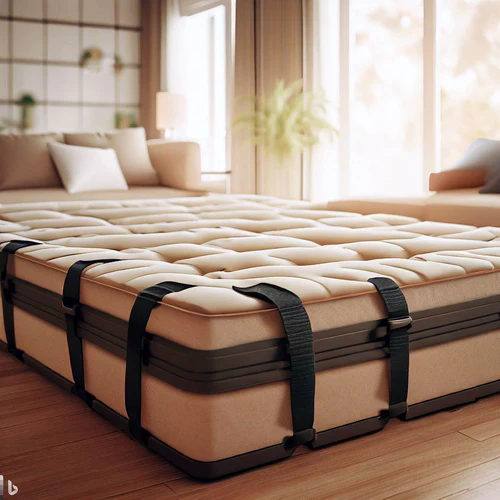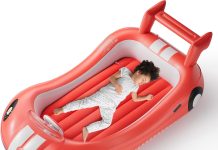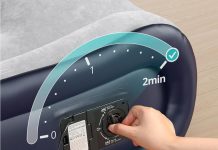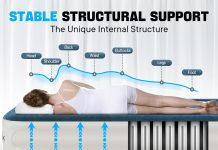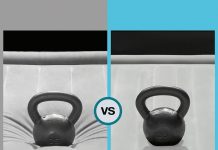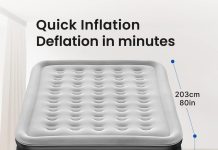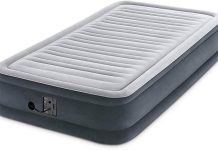Are you curious how to prevent your air mattress from slipping and sliding?
We’ve got you covered! In our article, you’ll discover some ingenious tips on how to keep your air mattress in place, ensuring a stable and comfortable night’s sleep.
Say goodbye to waking up in the middle of the night to readjust your mattress, and say hello to an anchored and secure sleeping surface.
From simple solutions like non-slip mats to more creative options such as makeshift grippers, we’ll explore practical techniques to have you sleeping like a baby on your air mattress.
Review contents
Choosing the Right Surface
When it comes to ensuring stability and preventing your air mattress from sliding, the first step is to consider the type of flooring you have in your room. Different types of surfaces offer varying levels of grip, so it’s essential to choose wisely.
If you have a hardwood or tile floor, using a non-slip pad or mat underneath your air mattress is highly recommended. These pads are designed to provide extra grip and prevent unwanted movements. They create a barrier between the mattress and the smooth surface, ensuring a more secure placement.
Placing your air mattress directly on the carpet can offer excellent stability for those lucky enough to have carpeted floors. The carpet fibers provide natural friction, making it less likely for the mattress to slide around. This is a simple yet effective solution that requires no additional accessories.
However, it’s important to note that not all carpets are created equal, and some may still allow for sliding. In such cases, considering the use of a non-slip pad or mat on top of the carpet can provide an added layer of security.
When avoiding slippery surfaces, it’s best to steer clear of materials like polished wood, linoleum, or vinyl. These surfaces lack inherent traction, making moving around easier for the air mattress. You can significantly reduce the risk of sliding by opting for a more textured or padded surface.
Using Non-Slip Sheets or Grippers
Another effective method for keeping your air mattress in place is using non-slip sheets or grippers. These handy accessories help create a firm grip between the mattress and the surface it rests on, providing enhanced stability.
One option is to attach Velcro strips to the mattress and bed frame. The Velcro’s gripping nature allows it to hold the mattress in place, preventing unwanted shifting. Affix the Velcro strips to the corners or edges of the mattress and corresponding spots on the frame and press them together for a secure connection.
Alternatively, you can use a non-slip rug grip underneath the air mattress. Rug grips are typically made of a grippy material that helps anchor objects in place. Placing a rug grip between the mattress and the surface can significantly reduce the likelihood of sliding.
If you’re looking for a more DIY solution, applying silicone caulk to the bottom of the air mattress can be surprisingly effective. The silicone caulk creates a tacky surface that offers improved grip, keeping the mattress in place. However, ensuring the caulk has dried thoroughly before using the mattress is essential to avoid damage.
Securing the Mattress with Straps or Bands
Securing the air mattress with straps or bands can provide peace of mind for those seeking a more robust solution. This method involves using adjustable straps with buckles to hold the mattress in place firmly.
Start by attaching one end of the strap to the bed frame, ideally near the head or foot of the mattress. Ensure the strap is securely fastened, then pass it underneath the mattress to the other side. Repeat the process for the opposite side of the mattress, pulling the strap taut. By adjusting the buckle, you can achieve the desired level of tightness to keep the mattress from sliding.
As an alternative to straps, wrapping bungee cords around the mattress can provide adequate stability. Start by placing the mattress on the bed frame, then loop the bungee cords around the mattress and through the frame. Connect the ends of the bungee cords securely, creating a tight hold. Avoid over-tightening the bungee cords, as it may cause discomfort when lying on the mattress.
Creating a Barrier to Holding the Mattress in Place
For those seeking a more creative solution, creating a barrier around the mattress can be an effective way to keep it from sliding. This method uses materials like PVC pipe, pool noodles, or foam pipe insulation to construct a frame or border.
Using PVC pipe as a frame barrier, you can create a physical boundary preventing the air mattress from shifting. Cut the PVC pipes to the desired length and attach them to form a rectangular or square shape that fits around the mattress. You can then place the mattress inside the frame, ensuring a snug fit. This method works particularly well when combined with a non-slip pad or gripper, providing a physical barrier and an enhanced grip.
Another creative option is to secure pool noodles or foam pipe insulation along the edges of the mattress. These materials act as buffers, preventing the mattress from sliding by creating a cushioned barrier. Cut the pool noodles or foam pipe insulation to match the length of each side of the mattress and secure them in place using adhesive or tape.
Inflating and Deflating Properly
While the method of inflating and deflating may not seem directly related to preventing sliding, it plays a crucial role in maintaining stability. Proper inflation and deflation techniques can significantly affect how well your air mattress stays in place.
To ensure optimal firmness, start by inflating the mattress to the recommended level indicated by the manufacturer. Over-inflating the mattress can cause it to become more rigid and prone to sliding, while under-inflation can result in excessive sagging. Finding the right balance will help maintain stability and prevent unwanted movement.
Interestingly, slightly deflating the mattress can also contribute to reducing sliding. This is because a fully inflated mattress may be too firm, causing it to be less adaptable to the surface it rests on. By slightly deflating the mattress, it becomes more pliable and better conforms to the contours of the underlying surface, providing a better grip and stability.
Using Furniture or Weight to Stabilize
Another practical approach to prevent your air mattress from sliding is to utilize the weight and stability of furniture or other heavy objects. Placing heavy furniture in strategic locations around the mattress can hold it in place and restrict any movements.
Ensure that the furniture you choose is sturdy and won’t shift quickly. Position the furniture to create a physical barrier against the mattress’s movement. Heavy bedside tables, dressers, or bookshelves can serve as excellent anchors and add extra storage space.
If you don’t have heavy furniture readily available, use weights or dumbbells to stabilize the mattress corners. Place these weights on the corners of the mattress, effectively increasing the overall friction and minimizing sliding. Please ensure the weights are securely positioned and won’t roll or slide themselves, as that could create a different problem.
Employing Grip-Enhancing Materials
To enhance the grip between your air mattress and the surface it rests on, you can utilize a few materials. These materials increase the friction between the mattress and the surface, reducing the chances of sliding.
A straightforward option is to sprinkle talcum powder or cornstarch on the surface before placing the mattress. These powders act as natural lubricants that reduce the stickiness of the surface, allowing the mattress to grip it more effectively. Be sure to spread the powder evenly to avoid clumps or patches that may cause discomfort.
Another helpful product is a rubberized undercoating spray. This spray-on material forms a textured, rubber-like surface that provides excellent grip. Apply the spray evenly on the surface where the mattress will be positioned, and allow it to dry completely before placing the mattress. The rubberized coating creates an anti-slip layer, ensuring the mattress remains in place even during restless nights.
Considering Mattress Design and Features
When purchasing an air mattress, it’s worthwhile to consider certain design features that can contribute to its stability. Opting for a mattress with a non-slip bottom is one feature that can significantly assist in preventing sliding.
Many air mattress manufacturers now offer models with specialized non-slip materials on the bottom surface. These materials are designed to provide enhanced grip and prevent any lateral or vertical movements. When shopping for an air mattress, look for this feature, as it can save you the trouble of implementing additional anti-sliding measures.
Another option is to choose a mattress with a built-in anchoring system. These systems often include straps or loops on the mattress’s sides or corners. You can achieve a much more stable sleeping surface by using these anchors in conjunction with the bed frame or other securing methods.
Regular Maintenance and Cleaning
Regular maintenance and cleaning are necessary to ensure that your air mattress remains in optimal condition and continues to stay in place. By keeping the mattress and surrounding area clean, you can maintain the effectiveness of anti-sliding methods.
Start by cleaning the floor regularly and removing dust, debris, or potential slipping hazards. Sweeping or vacuuming the area around the mattress prevents the accumulation of particles that can reduce grip or cause the mattress to shift. Additionally, ensure that the floor’s surface is free from spills or liquids that could create a slippery environment.
It’s equally important to clean the mattress, as debris or dirt particles can interfere with the grip. Follow the manufacturer’s instructions for cleaning your air mattress, and pay particular attention to removing any dust or dirt that may have accumulated on the bottom surface.
For those using non-slip pads or grippers, removing any dust or debris that may have been collected on these accessories is essential. Regularly inspect and clean the pads or grippers to maintain effectiveness and prevent any deterioration over time.
Alternative Solutions
If the previously mentioned methods don’t fully address your sliding issues, you can try a few alternative solutions. These methods can be instrumental if you’re dealing with persistent sliding or seeking additional measures for added security.
One option is to use an anti-slip rubber sheet between the air mattress and the surface it rests on. These rubber sheets provide a highly grippy surface, ensuring that the mattress stays put. Place the rubber sheet on the desired area, ensuring it covers the entire footprint of the mattress, and then place the mattress on top.
Another alternative is the use of double-sided carpet tape or rug grippers. These adhesive materials can be applied to the bottom surface of the air mattress, providing extra grip when placed on a smooth surface. Ensure to follow the manufacturer’s instructions for proper application to avoid any damage to the mattress.
Considering these alternative solutions, you can find the perfect method to keep your air mattress from sliding, ensuring a secure and comfortable sleeping experience.
In conclusion, keeping an air mattress from sliding requires some thoughtful consideration and the implementation of appropriate solutions. From choosing the suitable surface to employing grip-enhancing materials and utilizing securing methods, there are various techniques available to ensure the stability of your air mattress.
By taking the time to consider the options and investing in proper maintenance, you can enjoy a restful sleep without the worry of your mattress shifting around. Sweet dreams!

